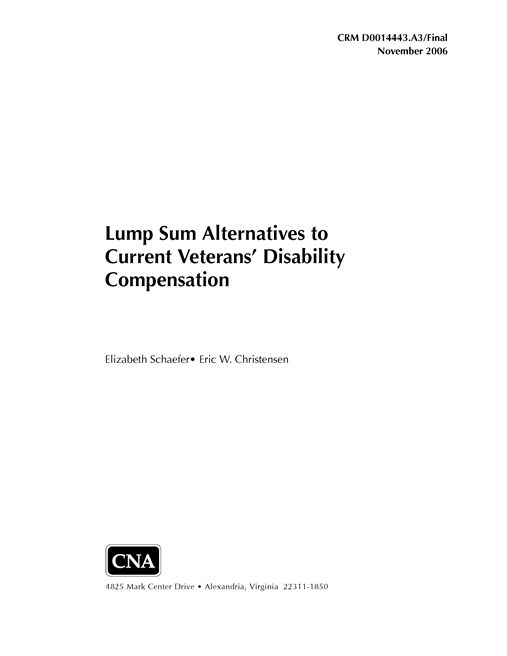The Department of Veterans Affairs currently provides lifetime monthly compensation payments to selected disabled veterans. The Veterans’ Disability Benefits Commission asked CNA to analyze the impact of lump sum payments to disabled veterans as an alternative to the current system. A lump sum program for disabled veterans would have potential advantages both for veterans and VA. Veterans could benefit from having more choice about how to use their compensation and from having fewer interactions with the VA. The VA, in turn, might be able to reduce its costs and administration for veteran disability compensation. CNA’s analysis of VA’s options shows that whether a lump sum program would actually yield such benefits without negative effects on veterans’ welfare would depend on the program design.
The Veterans’ Disability Benefits Commission (the Commission) has asked The CNA Corporation (CNAC) to provide a study of the issues involved in offering a one-time lump sum payment instead of the current lifetime monthly compensation payments to selected disabled veterans. This topic is of great interest because of the potential benefits both to veterans and to the Department of Veterans Affairs (VA).
In conducting this study, we explored the following questions:
- What are the advantages and disadvantages of a lump sum program to both disabled veterans and VA?
- What can we learn from other government lump sum programs?
- What are the key elements in the design of a lump sum program?
- Who would be eligible for a lump sum (i.e., which diagnoses and disability ratings)?
- What would be the cost and savings of a lump sum program?
Throughout this report, a repeated theme is the close connection between how the lump sum program would be designed and what its ultimate effects would be. For most elements in the design of a lump sum program, it is not clear which of several alternative approaches would best meet the dual goals of serving veterans better and reducing costs for VA.
Note that the Commission has also requested an assessment of the merits of modifying the structure of disability compensation to provide separate payments for loss in earnings and loss in quality of life. That assessment is a different effort from this study, and those results will be provided later in a separate report. This analysis considers a potential lump sum program only in the context of the current compensation structure.
Potential advantages and disadvantages of lump sum VA benefits
In conducting this analysis, we assumed that the goal of a lump sum program was to better serve disabled veterans and to do this at a lower cost than the current compensation program.
Advantages for veterans
There are a number of ways in which a lump sum program could serve disabled veterans better. One advantage is that some veterans might find a lump sum more useful than monthly payments. A second advantage would arise if the program were designed so that the lump sum were optional, because having the flexibility of a choice is generally considered inherently beneficial. A third advantage for veterans would be reduced administrative interactions with VA, which could improve the timeliness of claims processing overall, assuming VA staffing levels would not be reduced.
Advantages for VA
VA could also benefit from establishing a lump sum program. Savings in VA compensation costs would be generated if each lump sum were less than the present discounted value of the veteran’s lifetime monthly payment. Savings in VA administrative costs could arise simply from having fewer veterans in the system generating the routine costs associated with monthly payments. In addition, if lump sum recipients were not allowed to apply for re-rating of their disabilities, or if the circumstances for re-rating were restricted, then the costs of processing those applications would be eliminated or reduced.
Concerns about veterans’ welfare
Despite the potential advantages of a lump sum program, there are some key areas of concern about possible negative effects on veterans’ financial welfare. One concern is that the lump sum should be “fair” in comparison with lifetime monthly compensation payments. A related concern is the treatment of cases where a disability worsens. Another concern is that some veterans’ “unwise” use of their lump sums might jeopardize their basic financial welfare.
Discussion and analytical conclusions
A lump sum program for disabled veterans has potential advantages both for veterans and VA. Veterans could benefit from having more choice about how to use their compensation and from having reduced administrative interactions with VA. VA could potentially reduce its costs for compensation payments and administration. However, whether a lump sum program would in fact produce these benefits, without having any negative effects on veterans’ welfare, depends on the program design.
Approved for Public Release; Distribution Unlimited. Specific authority: N00014-05-D-0500.
Details
- Pages: 128
- Document Number: CRM-D0014443-A3-Final
- Publication Date: 11/1/2006
